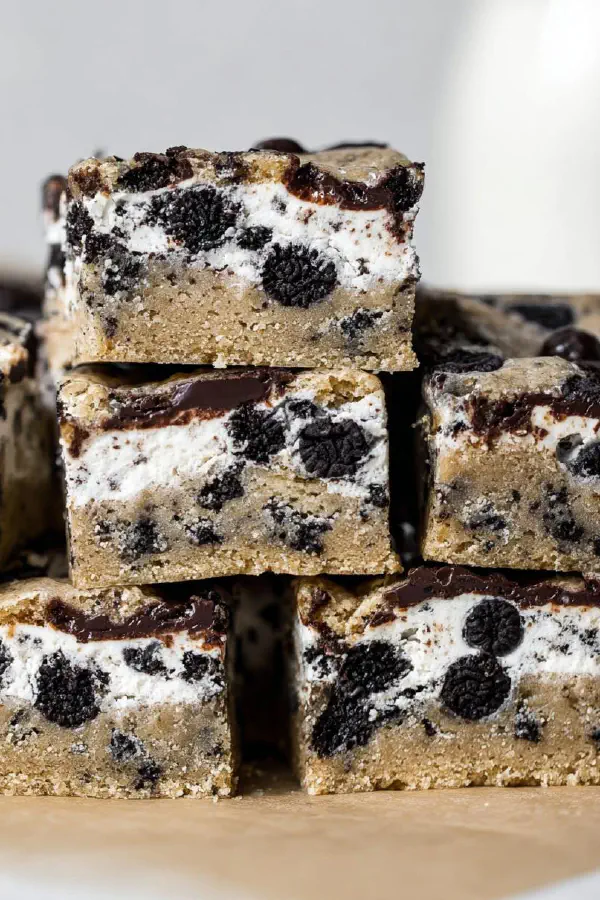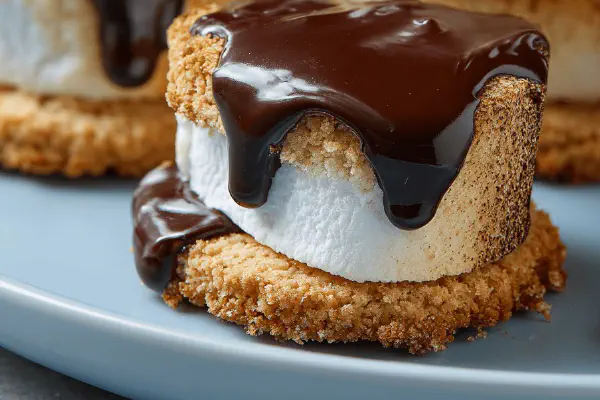Featured Recipe
Cookies Cream Bars Remix

By Kate
"
Crunchy bars combining all-purpose and oat flour with cornstarch, baking soda, baking powder, and salt. Creamed butter with white and light brown sugars set the base. Eggs and vanilla blended in for moisture and flavor. Chunky mix-ins include crushed Oreos, white chocolate chunks, and chopped cookies and cream candy bars. Baked in an 8x8 pan lined with parchment for easy lift-out. Press extra Oreo pieces on top before baking for texture contrast. Visual cues like golden edges and slightly soft centers trump timer. Cool before slicing. Yields 16 small bars, bites of sweet, chewy, crunchy textures balanced with creamy bits.
"
Prep:
15 min
Cook:
25 min
Total:
40 min
Serves:
16 servings
cookies
desserts
baking
chocolate
sweets
Introduction
Forget rigid instructions. Baking bars isn’t about blindly following time stamps or relying solely on a timer. Texture matters. The creaming step? Should be light, almost fluffy—not just mixed. It introduces air pockets that matter big time for softness. Tough dough means overmixed flour or cold butter. You want the dough pliable, nearly sticky without being soggy. Bent on chunk variety—white chocolate pushes sweetness differently than milk; chopped cookies add a soft crunch; Oreos give that iconic bite. Toss in oat flour to add chewiness and subtle nutty flavor. Trouble with candy bars sticking or melting? Chop chunky, cold, and stir in last minute. Parchment lining saves post-bake drama. The whole dance here prizes visual and tactile staircase: slight crust, soft sides, moist center. Don’t rush slicing; bars meltdown before setting up with cool air circulation. Keep cuts even, bars consistent size—presentation matters in shared bites. Baking bars with complex textures means knowing what to look for, smell for, and feel. Flour swaps or sugar tweaks shift moisture balance—adjust baking time to suit. Experience builds kitchen instincts.
Ingredients
About the ingredients
All-purpose flour can be partially swapped for oat or whole wheat flour to boost texture complexity but expect subtle flavor changes. Cornstarch softens tough edges and improves crumb so don’t skip it. Baking powder and soda together balance rise and browning; missing either risks dense or flat bars. Butter must be softened but cold butter chunks create pockets of flakiness—message: know your butter state before mixing. White and light brown sugars combine crisp and chewiness; brown sugar’s molasses content holds moisture and flavor. Vanilla extract’s importance often overlooked—it brings depth. Eggs and yolks hydrate and bind but adding too much risks dense texture—stick to given amounts. Oreos and cookies and cream candy bars add recognizable crunch and cream flavors—a twist is substituting white chocolate chunks for mini chocolate chips to up sweetness with sharper melt. Pantry substitutions possible but expect flavor and texture tweaks. Allergic? Use sunflower seed butter instead of butter but monitor baking time carefully.
Method
Technique Tips
Hear the creaming clack of paddle beating butter and sugars? It indicates trapped air essential for tenderness. Don’t skip sifting dry ingredients; it avoids pockets of baking powder or soda that cause uneven rise or bitter notes. Mix eggs one at a time to avoid curdling or uneven batter hydration. Incorporate dry slowly; vigorous mixing creates gluten strands leading to tough bars. Fold in Oreos and chunks gently to prevent pulverization of texture but evenly distributed. Press dough evenly in pan with light pressure only—excess compression leads to dense, uneven cooking. Top with extra crumbs before baking—they toast and add crunch contrast versus soft interior. Oven spring depends on temp accuracy—355°F is better than 350° if oven runs cool. Watch browning on edges and slight dome that flattens as bar sets indicating doneness. Toothpick should come out with moist crumbs, not wet batter—damp crumbs signal just right. Remove promptly from oven to cool to avoid overbake carryover. Cool fully for neat cuts or you’ll get crumbled edges, ruined bars. Clean sharp knife warmed between cuts helps achieve clean edges. Store loosely covered—trap moisture, but avoid plastic wrap touching surface that causes sogginess.
Chef's Notes
- 💡 Don’t rush softening butter. Overcold—texture off. Should feel pliable, almost oily to touch. You want creaminess in batter. Cream until fluffy—nearly 4 minutes. Air pockets matter for chewiness. Lumps in dry mix? All good. Just don’t skip whisking. Lightly mixed. Helps rise evenly.
- 💡 Chop candy bars cold. Room temp? They melt into nothing. You want little chunks, distinct bites. Same with Oreos. No pulverizing. Snapping sound? Good. You’ll know mix-ins hold texture. Press batter lightly in pan—don’t squish it. Repeat: less pressure, better rise. Too dense? You’ll be sad.
- 💡 Watch edges while baking. Golden brown but not burnt, center stays slightly soft. That’s your doneness cue. Toothpick trick? Few crumbs attached, not wet batter. Pull before overbake—carryover cooking happens. Let cool a bit. Make clean cuts later. Messy cuts ruin whole batch.
- 💡 Storing bars? Loose coverage keeps them tender. Plastic wrap directly on surface? Mistake—sogginess awaits. Best in container with lid—hydrate the air without trapping moisture. Scale down? Adjust ingredient amounts as needed. Half batch? Works but free up time for testing. Don’t skip mixing.
- 💡 Adjust baking time if ingredient swaps happen. Whole wheat flour? Increase moisture, may need longer. More sugar? Bars could spread out. Watch baking closely. If using mini chocolate chips? Sweetness game changes. Expect variation in crunch too. Key is visual cues.
Kitchen Wisdom
What’s the best way to know when bars are done?
Golden edges, slight bounce if touched. Look for browning but not burnt. Cool, then slice. Just right texture signals success. Underbaked? Too moist in middle.
Can I substitute butter?
Sunflower seed butter works. Expect changes in flavor. Baking time varies. Monitor closely for doneness. Same with oils, but may lose texture. Adjust expectations.
What’s a common issue with storage?
Bars turning soggy overnight? Keep them loosely covered. Baking parchment helps too. Avoid plastic touching surface—sweat builds up. Freshness matters; eat sooner.
Any tips for mixing dry ingredients?
Sift them. Avoid clumps funneling into batter. No dry pockets later. Mix slowly; avoid tough bars. Gluten formation is real. Remember—keep it light. Fold carefully.



